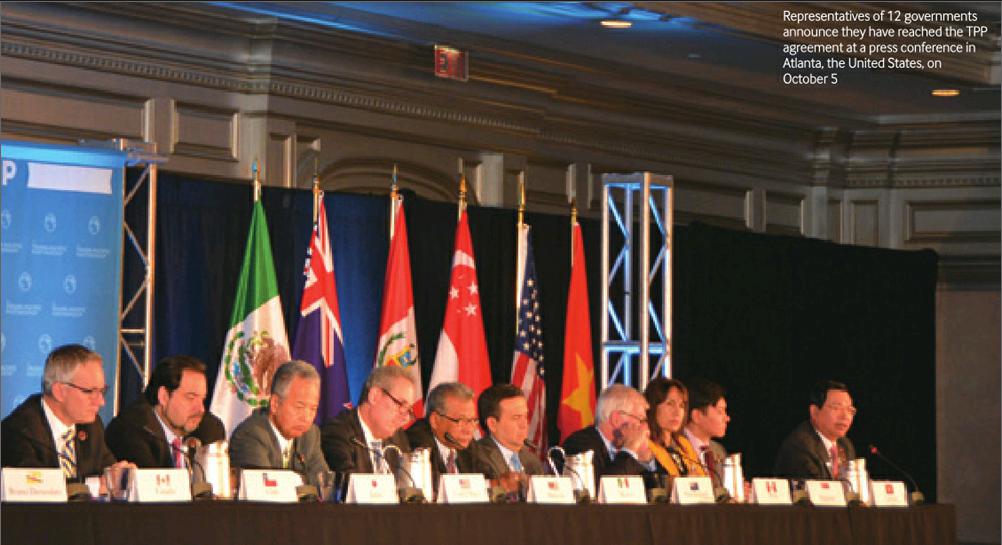DECODING THE TRANS-P PARTNERSHIP
2015-11-05ByWangJiangyu
By+Wang+Jiangyu

After five years of talks, the Trans-Pacific Partnership (TPP), a trade agreement between the United States and 11 selected trading partners bordering the Pacific Ocean, was finally penned on October 5. In China, the agreement has triggered extensive coverage and a heated debate.
Among Chinese experts, there exist various opinions in regard to both the perceived effects of the TPP agreement itself and the process by which parties to the agreement were chosen. Some believe that the TPP is a strategic exercise by the United States to try to “contain” Chinas rise in economic power and geopolitical influence. Others have concerns as to whether the TPP represents a threat to the position of the World Trade Organization (WTO) as the standard-bearer of global trade rules. Still some view the agreement optimistically; believing this could be a stimulus for Chinas further integration into the world economy. It is reasonable to discuss all of these positions as possible outcomes for China, because the details of the final TPP agreement are as yet still widely unknown.
By definition, the TPP should constitute a free trade agreement among major trading partners in the Asia-Pacific region. But the multilateral talks excluded China, one of the most important trading partners for many countries in the region, including the United States. This has consequently aroused perhaps not unjustified suspicion.
Why the exclusion?
First and foremost there is a question about the strategic intentions of the United States. Has the TPP been created to “contain” China? The answer might well be both “yes” and “no.”
China has become an undisputed significant and growing player in the global economy. With regard to economic ties, China and America are highly interdependent, both in terms of trade and increasingly in regards to foreign investment. It is impossible for the United States and its TPP counterparts to “contain” China. Moreover, doing so would not be in the interest of the United States or its fellow signatories.
Yet the TPP is extremely relevant to China. According to the media, the West has reached consensus that the TPP would be the best tool to recalibrate Chinas growing influence on world economy and trade. For example, a recent article by The New York Times was entitled “U.S. Allies See TransPacific Partnership as a Check on China.”
Some U.S. officials and even U.S. President Barack Obama have explicitly repeated that the TPP is in fact designed to provide a counterbalance to Chinas global reach. “We cant let countries like China write the rules of the global economy. We should write those rules,”President Obama said in a statement on October 6.
To be honest, whatever the presumed“real” purpose of the TPP is, it will be insufficient in its ability to “contain” China, which boasts a massive, diverse economy and has deep and broad financial relations with most of the worlds economies. In the perspective of geopolitics, the U.S. promotion of the TPP is an effort to place a check on Chinas growing strength and can be seen as a preemptive measure to secure future U.S. leadership in the region. The TPP is clearly a cornerstone of the Americans strategy in the Asia-Pacific region.
In the first decade of the 21st century, the American administration of President George W. Bush was focused on “the war on terror” in Afghanistan and Iraq. The traditional role of the United States as the hegemonic power in the Asia-Pacific region was maintained purely by the inertia of its historical strength. As a result, the United States failed to forge closer ties with its AsiaPacific allies during that period of time.
Meanwhile, Chinas national strength was growing rapidly and its annual GDP had doubled. The country subsequently changed its foreign policy from keeping a low profile to becoming more outward looking. It is safe to say that the rise of China coincided with U.S. negligence in the region.
President Obama, however, has made significant adjustments to U.S. foreign policy since he took office in January 2009. Under his leadership, overseas counterterrorism is not the only factor impacting decision-making in Washington. Instead, the emphasis of Obamas foreign policy is to recoup the United States global influence. As a result, the administrations strategic “pivot to Asia”was rolled out in 2011.
The rebalancing strategy consists of three aspects. With respect to the military, the United States is reallocating its armed forces abroad. Approximately 60 percent of U.S. forces will now be deployed in the Asia-Pacific region. Europe had historically been the region where most U.S. troops were stationed.
Secondly, the U.S. Government is practicing “smart power” diplomacy, making use of some other Asian-Pacific countriesconcerns over Chinas rise in order to build an alliance that can counter decisions made in Beijing. Thirdly, Obama is keen to promote the TPP as a way to enhance economic ties with many Asian-Pacific countries, and to try to ensure new trade rules are written under U.S. leadership.
Is China to blame?
Put simply, no. Since the United States itself joined the TPP talks, it has never been its intention to invite China into the discussions, though it has not taken its eye off of the worlds second-largest economy. The reason is simple: The United States wants to write global trade rules and the easiest way to do so is to call on its closest allies to participate in the initial talks. If China were involved, it could effectively negotiate with the United States on many points of contention, and influence the substance of the final agreement.
In contrast, the majority of the other 11 countries participating in the talks were encouraged by the U.S. Government. Japan was not initially eager to join the talks, but the Americans spent considerable time convincing the Japanese leadership of the benefits of doing so. But when China displayed interest in the TPP, the United States reacted passively, usually indicating that China may be welcome to join the talks at some unspecified point in the future, but only after the terms had already been set.
Any argument which attributes Chinas TPP exclusion to its failure to honor its WTO commitment is ungrounded. Since its entry into the WTO in 2001, China has made great efforts to adjust its domestic laws and open its market in order to fulfill its WTO obligations. There are two authoritative sources which monitor member economies commitments. One is WTOs trade policy review mechanism and the other is Americas own Office of the United States Trade Representative. The reports released by the two bodies never contend that China has failed to live up to its WTO obligations as a whole. For any disputed case in which Chinas practices were judged incompatible with WTO rules, China has complied with the judgment and revised the relevant domestic laws.
Still others claim that China is not qualified to join the TPP because of problems in its economic situation, but this highlights a double standard with respect to TPP signatories. On one hand, the United States alleges the TPP will set the highest international standards. On the other, it has solicited countries to join who themselves possess wide development gaps. As for market openness, China is far ahead of Viet Nam, though the latter country was invited to join the trade pact.
A misjudgment
Over the past few years, some of Beijings efforts to improve regional and international trade rules may have led to the resolution to construct the TPP agreement without China.
Many economies had begun to focus on bilateral and regional free trade agreements (FTAs) when the WTO kicked off its Doha Round negotiations in 2001. Since the Doha negotiations made little progress over the last decade, many countries looked to further strengthen regional economic integration instead.
China didnt hesitate to participate in building bilateral and multilateral FTAs after seeing the international tendency to do so. As early as 2000, it had proposed to work together with the Association of Southeast Asian Nations (ASEAN) to reach a new FTA. The framework of the China-ASEAN FTA was inked in 2003 and the entire agreement came into effect in 2010. Stimulated by the achievement, Japan, South Korea and India have since each signed FTAs with ASEAN.
The United States was obviously excluded by this round of regional economic integration within Asia, and had felt uncomfortable over Asias efforts toward economic integration in the absence of U.S. participation. Some Asian countries, including China, are not willing to have the United States involved in internal Asian affairs. The Chinese leadership had been very cautious when promoting regional FTAs. They believed Asian countries should have priority in building the “ASEAN plus three”(China, Japan and South Korea), before expanding the model to other countries, such as India, Australia and New Zealand. Under the framework of “ASEAN plus three,”Beijing planned to take a leadership role and assert its growing influence.
In February 2008, the Bush administration announced that the United States would join the TPP and invite Australia, Peru and Viet Nam to do the same. This announcement signified the beginning of U.S. action to dominate the process of regional economic integration in Asia-Pacific region.
During his first visit to Asia in 2009, President Obama officially declared Americas participation in the TPP negotiations.
Later in 2011, the Obama administration declared the policy of pivoting to Asia as a strategic focus for its foreign policy, as a way to rebalance Chinas growing influence in the region through a series of military, diplomatic and economic measures. As mentioned, the TPP is thought of as a critical juncture in the implementation of this policy.
Since the United States joined the TPP talks, China has shown its support for building the Regional Comprehensive Economic Partnership that was proposed by ASEAN and then called for efforts to build the Free Trade Area of the Asia-Pacific. Both were projects that China was not initially interested in. But these passive reactions only reflect Chinas inability to commit to innovative, long-term, stable and strategic foreign policy planning.
Furthermore, Chinese scholars were not sensitive to the development of the TPP talks until the negotiation is largely concluded with a successful outcome. Much needs to be improved in the academic circles to prevent misjudgment on issues of vital concern to national interest in the future.
